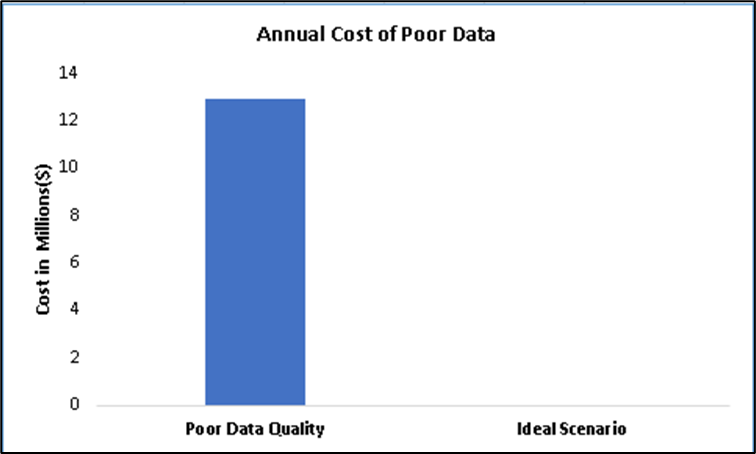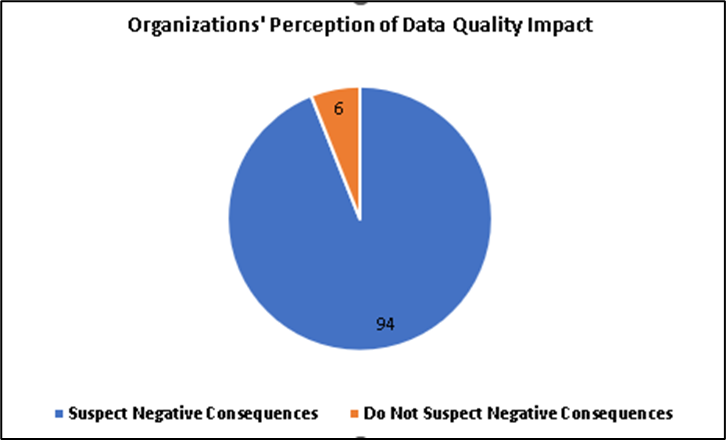The Hidden Costs of Dirty Data: A $12.9 Million Problem for Businesses
In an era where data drives decision-making, a silent threat is costing companies millions: dirty data. Recent studies reveal that poor data quality is more than just a technical nuisance; it's a financial burden that is hitting businesses hard.
According to a report by Gartner, organizations lose an average of $12.9 million annually due to poor data quality. This staggering figure encompasses direct costs like wasted marketing spend and operational inefficiencies, as well as indirect costs such as missed opportunities and reputational damage.
To illustrate the magnitude of this issue, consider the following chart:

Source: Gartner Report 2023.
This stark comparison underscores the potential savings and efficiency gains that could be achieved through improved data management practices.
The Pervasive Nature of Dirty Data: The problem is pervasive. Dirty data can infiltrate an organization's systems through various channels, including human error during data entry, system migrations, and outdated information. What makes it particularly insidious is its ability to spread throughout an organization's ecosystem, affecting multiple departments and processes.
“When your company is swimming in dirty data, the sales and marketing teams cannot make well-informed and accurate, data-driven decisions,” wrote Angie, a data expert from Cazoomi. “On average, organizations believe that 25 per cent of their data is inaccurate, a factor that impacts on the bottom line”.
Decision-Making Paralysis: The impact extends beyond financial losses. It can lead to decision-making paralysis, where executives and managers, lacking confidence in their data, revert to gut feelings or outdated heuristics. This negates the potential benefits of data analytics investments and can result in missed market opportunities or ineffective strategic planning.
Regulatory and Compliance Risks: In heavily regulated industries such as healthcare and finance, the risks are even higher. Inaccurate reporting due to data quality issues can lead to hefty fines, legal troubles, and significant damage to an organization's reputation.
The Ripple Effect on Customer Experience:Customer experience is another area where the effects of dirty data are keenly felt. Incorrect customer information can lead to personalization failures, irrelevant marketing communications, and frustrating service experiences. In an age where customer loyalty is hard-won and easily lost, such data-driven missteps can have long-lasting consequences.
The Gravity of the Situation:The gravity of the situation is not lost on business leaders. A Gartner report indicates that 94% of organizations suspect that poor data quality leads to negative business outcomes. This widespread concern is visualized in the following pie chart:

Source: Gartner Report 2023.
This stark contrast highlights the critical importance of addressing data quality issues. These findings underscore the necessity for organizations to prioritize data cleaning and management to mitigate risks and enhance decision-making.
As businesses grapple with these challenges, innovative solutions are emerging. One such solution is the Data Cleaning Tool: “The Lazy Man’s Kit”, a comprehensive data cleaning tool designed to address the most common data quality issues faced by organizations. The application offers features such as:
1. duplicate removal
2. data type conversion
3. handling of missing values
“The Lazy Man’s Kit” directly targets the problems highlighted in this article. Experience the power of clean data for yourself. Try free for four weeks and see how it can transform your data management processes. Visit the Data Cleaning Tool. For those interested in staying updated on the latest developments in data quality management, a newsletter subscription is available www.theprobabilityanalyst.com. Subscribers receive regular insights, tips, and exclusive offers related to data cleaning and management.
Given the multifaceted costs associated with dirty data, the importance of data cleaning becomes clear. Data cleaning is the process of detecting and correcting (or removing) corrupt or inaccurate records from a dataset. Implementing robust data cleaning processes offers numerous benefits:
1. Improved Decision Making: Clean data provides a solid foundation for analytics and business intelligence, leading to more accurate insights and confident decision-making.
2. Increased Operational Efficiency: By eliminating errors and inconsistencies, organizations can streamline their operations, reducing waste and improving productivity.
3. Enhanced Customer Satisfaction: Accurate customer data enables personalized experiences and effective communication, fostering loyalty and positive brand perception.
4. Regulatory Compliance: Clean data helps organizations meet regulatory requirements more easily, reducing the risk of fines and legal issues.
5. Cost Savings: While data cleaning requires an investment, it ultimately leads to significant cost savings by preventing the myriad issues associated with dirty data.
Implementing Data Cleaning Strategies: Data cleaning is an ongoing process that should be integrated into an organization's data management strategy. The key components of a robust data cleaning approach include:
1.Data Profiling: Regular assessment of data quality and characteristics
2. Standardization: Enforcing consistent data entry standards
3. Validation: Implementing accuracy checks at data entry points
4. Deduplication: Identifying and merging duplicate records
5. Enrichment: Supplementing data with additional information from reliable sources
6. Automation: Using technology to automate routine data cleaning tasks
These strategies aim to ensure data consistency, accuracy, and completeness while improving efficiency in data management processes.
Conclusion
The hidden costs of dirty data are pervasive and significant, affecting every aspect of an organization from its financial performance to its customer relationships. As data continues to play an increasingly central role in business operations and strategy, the importance of data cleaning cannot be overstated. Investing in data cleaning is not merely a technical necessity but a strategic imperative.
Organizations that prioritize data quality through comprehensive cleaning processes position themselves to make better decisions, operate more efficiently, and deliver superior customer experiences.
In contrast, those that neglect data cleaning risk operating on flawed insights, incurring unnecessary costs, and falling behind more data-savvy competitors.
In the digital age, clean data is a valuable asset that can drive innovation, efficiency, and growth. By recognizing the hidden costs of dirty data and taking proactive steps to ensure data quality, organizations can unlock the full potential of their data assets and gain a significant competitive advantage in their respective markets.